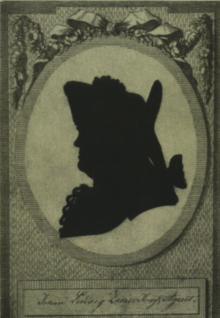Johann Ludvig Zinn
Johann Ludvig Zinn (14 September 1734 - 3 February 1802) was a German-Danish merchant who founded a trading house in Copenhagen in 1765 and died as one of the wealthiest men in the city. Zinn lived in the Zinn House at Kvæsthusgade 3 in Copenhagen. His daughter, Sophie Dorthea Zinn, has written about her father in her memoirs, Grandma' Condma's Confessions (Grandmamas Bekjendelser).
Johann Ludvig Zinn | |
|---|---|
 Silhouette by | |
| Born | 14 September 1734 |
| Died | 3 February 1802 (aged 67) Copenhagen, Denmark |
| Nationality | German-Danish |
| Occupation | Merchant |
Early life and education
Zinn was born in Mainbernheim in Bavaria. His parents were Johann Friederich Zinn and Dorothea Barbara Zinn, née Kreis.
Career and public life
Instegated by Johan Friederich Wewer, Zinn came to Denmark in 1757 where he initially worked for Fabritius & Wewer. He established his own trading house in 1765. He was appointed to royal agent in 1779.
He served as a commercial specialist judge at Copenhagen's Maritime Court and he was a member of the city's Council of 32 Men in 1772-1802. He also served as Statutory auditor In Danish Asia Company. In 1789 he was a member of a commission set up to regulate Copenhagen's grain reserves (provianteringskommission ). He was president of Grosserersocietetet from 1790 and until his death.[1]
Personal life and lagacy
.jpg)
Zinn married Johanna Charlotta Sophia Preisler (15 June 1754 - 3 September 1833) on 15 September 1771. She was a daughter of professor at the Royal Danish Academy of Fine Arts Johan Martin Preisler and Anna S. Schuckmann (1720-1800). His wife bore him four children, two sons and two daughters.
.jpg)
The family lived in the Zinn House at Kvæsthusgade 3. Zinn was naturalized in 1793 and donated a ballot box in silver to the city of Copenahgen to show his gratitude for the way he had been received.[2]
He died a very wealthy man on 3 February 1802 and is buried in Frederick's German Church. His two sons, Carl Ludvig Zinn (1777-1808) and Johann Friederich Zinn (1779-1838) took on the company after their father's death. In 1809 it was the second-largest company in Copenhagen based on tax income.[1] Carl Ludvig Zinn bought Vodroffsgård in 1803 but died in 1808.The company was later passed on to Johann Friederichs Zinn 's son Ludvig Maximilian Zinn (1808– 68). His sister, Emma Sophie Amalia, married the composer Johan Peter Emilius Hartmann.
Zinn's daughter, Sophie Dorthea Zinn, has written about her father in her memoirs, Grandma' Condma's Confessions (Grandmamas Bekjendelser).
See also
References
- "J.L. Zinn" (in Danish). Dansk Biografisk Leksikon. Retrieved 2 March 2018.
- "Kunsten at kringle en københavner" (in Danish). Information. Retrieved 26 February 2018.
External links
| Wikimedia Commons has media related to Johann Ludvig Zinn. |
- Johan Ludvig Zim at geni.com
- Source
- Source
- Spurce